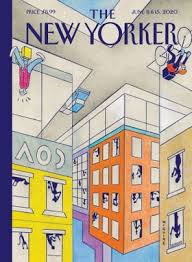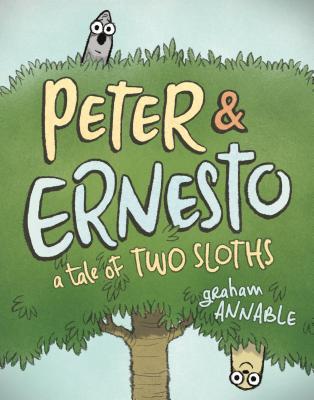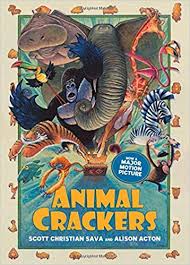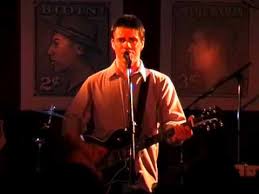 SOUNDTRACK: DIRTY THREE-Tiny Desk Concert #245 (October 15, 2012).
SOUNDTRACK: DIRTY THREE-Tiny Desk Concert #245 (October 15, 2012).
 For a Murakami collection I should really have picked a jazz Tiny Desk Concert. But none jumped out at my on my list. So I decided to do something that might be jazzy in spirit, even if it is nothing like jazz at all.
For a Murakami collection I should really have picked a jazz Tiny Desk Concert. But none jumped out at my on my list. So I decided to do something that might be jazzy in spirit, even if it is nothing like jazz at all.
Dirty Three are a three-piece band which consists of violinist Warren Ellis (who works closely with Nick Cave), drummer Jim White (who I had the pleasure of seeing live with Xylouris White), and guitarist Mick Turner (who has released a string of gorgeous instrumental solo albums and worked a lot with Will Oldham).
I’ve liked Dirty Three for years, although I kind of lost touch with them back around 2000. So it was fun to see that they are still working. (They’ve released all of 3 albums since 2000).
Jim White plays an eccentric but very cool style of drum–it always feels improvised and random, and maybe it is, but it’s never “wrong.” Turner is the only one who is keeping the song, shall we say, “stable.” He’s got the rhythm and melody both with his strumming. And Ellis is all over the place with melody lines and bowing.
For this Tiny Desk, they play three songs. Their music is ostensibly instrumental although Warren Ellis is not above shouting and yelling and keening when appropriate.
The first two songs are from their 2012 album and the last one is from Ocean Songs.
“Rain Song” opens with Ellis strumming the violin while Turner plays slightly different chords. Then Ellis takes off on a series of spiralling violin rolls. As always, White is back there waving his arms around with the loosest grip on drumsticks I’ve ever seen. He plays brushes on this song but the drums are far from quiet. Meanwhile Ellis is soloing away, yelling where appropriate and doing high kicks when White hits the cymbals. As the song comes to an end, White is going nuts on the drums and Ellis takes off his jacket (revealing a wonderful purple shirt) . He starts screaming wildly as he physically gets into his violin playing.
“The Pier” is about realizing that it’s the rest of the world that is driving you crazy. It’s about “trying to undermine Facebook and realize a new way of communicating with people beyond the internet.” It’ about… are you ready Mick? Okay. “The Pier” is a slower song with some plucked violin. Ellis climbs up on the desk and dances around as he plays. This one feels a but more controlled but in no way staid.
For “Last Horse in the Sand,” white switches to mallets and adds a tambourine to his cymbal. It’s really interesting to watch White play around with things–moving his gear around as he plays. He switches sticks and seems to be not even paying attention, but without ever really losing momentum or timing. For this song, Ellis and Turner are the mellow ones while White is just all over the place with his amazing drumming.
I haven’t said anything about Turner because he is really the grounding of the band, while the other two are taking flights of fancy.
This is a wild and untamed set and it’s a lot of fun. It’s also amusing to watch the audience witnessing this seeming chaos.
[READ: December 16, 2016] Slow Reader Vol. 1
Madras Press had released 16 small books, which I enjoyed reading quite a lot. I have posted about some and will post about more in the new year. But word is that they have given up on the small books and have switched their attention to a new magazine/journal called Slow Reader. The first issue came out this month and it collects stories, essays, poems, illustrations, and other things that center around novelist Haruki Murakami.
Support this small press! You can order this issue directly (and name your price, although I think the asking price is $6).
From an article elsewhere I’ve learned that future issues will cluster around M.F.K. Fisher, Kazuo Ishiguro, and Patricia Highsmith.
This issue contains essays, fiction and illustrations, some dating back as far as 2000.
CHIP KIDD-cover illustration (wind-up bird)
Chip Kidd is awesome
GRANT SNIDER-Murakami Bingo Board
This bingo is hilariously apt–covering most of the bases of Murakami’s writing: cats, jazz, running, and even a Chip Kidd cover.
JESSE BALL-Sheep Man
A line drawing of a sheep standing upright with the caption “The sheep man’s peculiar tail was never visible to me.”
HARRIET LEE-MERRION-Diner illustration
A nice line drawing of a corner diner
KAREN MURPHY-Sputnik and two moon illustrations
Two simple drawings of Sputnik and two moons.
BEIDI GUO-Hard Boiled Wonderland and the End of the World map
A cool map of the locations of the novel.
DINA AVILA–Murakami Tasting Menu at Nodoguro in Portland, OR
I don’t really get if the menu items are related to the stories but it’s a neat idea that there are foods named after his works. But why are so many called IQ84?
EUGENIA BURCHI–IQ84 menus
A drawing of foods with what I think are character names (I haven’t read the novel yet).
FABIO VALESINI-train illustrations taken from the book trailer for Colorless Tsukuru Tazaki and His Years of Pilgrimage
No idea what the original context is, but it’s a neat, clean drawing of a train station.
JEFFREY BROWN-“In Conversation” What Jeffrey Brown Thinks About
The first piece is an amusing cartoon in which Brown scores a job at an indie bookstore by mentioning Murakami. The little blurb says that it is an only slightly exaggerated account. There’s also a later picture by Brown of Murakami’s face posted on a bulletin board (with a lost cat flier), that’s really great.
DANIEL HANDLER-“I Love Murakami”
Handler begins his piece by apologizing to dozens of authors before saying that Murakami is our greatest living practitioner of fiction. He mentions a few books but heaps a ton of praise on Wind Up Bird Chronicles and mentions his excitement at finally getting Norwegian Wood in English (it had been untranslated for many years). He wrote this essay in 2000.
YOKO OGAWA-“On Murakami’s “The Last Lawn of the Afternoon” [Translated from the Japanese by Stephen Snyder]
Ogawa writes about a house in her neighborhood which has a lawn that she finds unsettling–it’s perfectly manicured and a pale, cool shade of green. She is reminded of the Murakami story in which a boy mows a woman’s lawn and she asks him an unexpected question. Ogawa imagines a woman in that home asking the same kinds of questions.
ETGAR KERET-“What Do We Have in Our Pockets?”
This was inspired by Murakami’s story “On Seeing the 100% Perfect Girl One Beautiful April Morning.” This story is about a man whose pockets are always bulging with unusual items. People often say to him, “What the fuck do you have in your pockets?” And his answer is that he carries things that he imagines the perfect woman needing–a stamp or a toothpick. It is a wonderfully charming story.
RIVKA GALCHEN-“The Monkey Did It”
Of all of the items in this collection, this is the only piece I’d read before. I remembered parts of it (particularly the excerpts from “A Shinagawa Monkey,” and her talking about Colorless Tsukuru Tazaki. I also recalled her saying that she liked his short stories better than his novels, but that she was perhaps wrong in thinking that. The one thing I didn’t pick up on last time was that in the beginning of the essay she writes about Toricelli’s Trumpet or Gabriel’s Horn–an item with finite volume but infinite surface area. She says this perfect describes Murakami’s work. And I love that she ties it to translator Philip Gabriel who is a gentle and modest translator–perfect for the watery novel.
TESS GALLAGHER-“Murakami and Carver Meet at Sky House”
Before he had written any substantial works, Murakami translated Raymond Carver’s works into Japanese. Ray was excited and bemused that Haruki and his wife Yoko would travel from Japan to meet with him. This essay tells us that the following poem came about as Ray tried to imagine how his poems could possibly be appreciated in Japan. Murakami told him how both the Japanese and American people of the 1980s were experiencing humiliation at being unable to make a decent living. Gallagher says that if they were to meet today Ray would be awkward about Haruki’s stature. But he would have loved knowing that Murakami had translated everything he had written.
RAYMOND CARVER-“The Projectile”
This poem is wonderful. It begins with Carver speaking about his meeting with Murakami and then flashing back to when he was 16 and was hit with an ice ball. It was thrown from someone in the street through a small crack in the window of the car he was riding in–a chance in a million.
RICHARD POWERS-“The Global Distributed Self-Mirroring Subterranean Neurological Soul-Sharing Picture Show”
This is the most abstract and “intellectual” of the essays here. It speaks of a team of neuroscientists discovering a lucky accident–that neurons in the brain fire when someone else makes a motion that we recognize. Similarly, in Murakami–representation is the beginning of reality. He speaks of the parallel narratives in Hard Boiled Wonderland. He wonders at the universality of dreams and ideas in Murakami. “But if his own stories are steeped in the endless weirdness hiding just inside everyday life, how then to account for Murakami’s astonishing popularity throughout the world?”
MARY MORRIS-“The Interpreter”
I loved this story. An American business woman is giving a series of lectures in Japan. She is assigned a translator who goes with her nearly everywhere. She is a little annoyed that he is always there, but he is very respectful of her and only speaks when spoken to. She assumes he is translating her speeches correctly, but during one, the audience laughs where there was nothing funny. She doesn’t want to disrespect him, but she can’t imagine what he said to them. In the next one, they are practically doubled over with laughter at what he says. Finally she has to confront him about it. He reveals astonishing insights into her personal life. And the next day he is called away–just as she has begun to feel close to him.
In the author’s note, she says that the she was at an writer’s meeting in Princeton (where she teaches) and Murakami was there eating with them. He was by himself, and she talked to him because she was a fan of his work. She relates a story of holding up a sign for him when he ran the New York City Marathon. She says that the part about the translator and his family (which I didn’t mention) is from an actual translator she met in Japan.
AIMEE BENDER-“Spelunking with Murakami”
Bender speaks of trusting Murakami. She says when the cat started speaking in one of his books, she began to mistrust him. Nevertheless, she says, she loves a lot of writers but only trusts a few of them. She’s not trusting Murakami’s honesty or his ability to make her smarter. Rather, she trusts him like a man with a torch in a cave–someone who is willing to explore–and to be in front leading the way.
SUMANTH PRABHAKER-Editor’s Note
Prabhaker would like to ask the world’s philosophers why some things seem to happen to us in a random fashion.
Read Full Post »
 SOUNDTRACK: IMMANUEL WILKINS-Tiny Desk (Home) Concert #164 (February 3, 2021).
SOUNDTRACK: IMMANUEL WILKINS-Tiny Desk (Home) Concert #164 (February 3, 2021). Immanuel Wilkins is a saxophone player who creates mellow but poignant jazz.
Immanuel Wilkins is a saxophone player who creates mellow but poignant jazz.
 SOUNDTRACK: KAWABATA MAKOTO [河端一]-Jellyfish Rising (2005).
SOUNDTRACK: KAWABATA MAKOTO [河端一]-Jellyfish Rising (2005). Recently, Kawabata Makoto [河端一], mastermind behind Acid Mothers Temple, revealed
Recently, Kawabata Makoto [河端一], mastermind behind Acid Mothers Temple, revealed 






 The Rheostatics, live at the Legendary Horseshoe Tavern in Toronto, November 14, 2004. This was
The Rheostatics, live at the Legendary Horseshoe Tavern in Toronto, November 14, 2004. This was 






 Laura Gibson performed the first Tiny Desk Concert in 2008. The whole enterprise was started because of her. Bob had seen her in a club and her quiet music was overpowered by the audience. So he invited her to play in his quiet office. And now, here it was 200 shows later and Gibson is back–the first person to headline twice.
Laura Gibson performed the first Tiny Desk Concert in 2008. The whole enterprise was started because of her. Bob had seen her in a club and her quiet music was overpowered by the audience. So he invited her to play in his quiet office. And now, here it was 200 shows later and Gibson is back–the first person to headline twice.